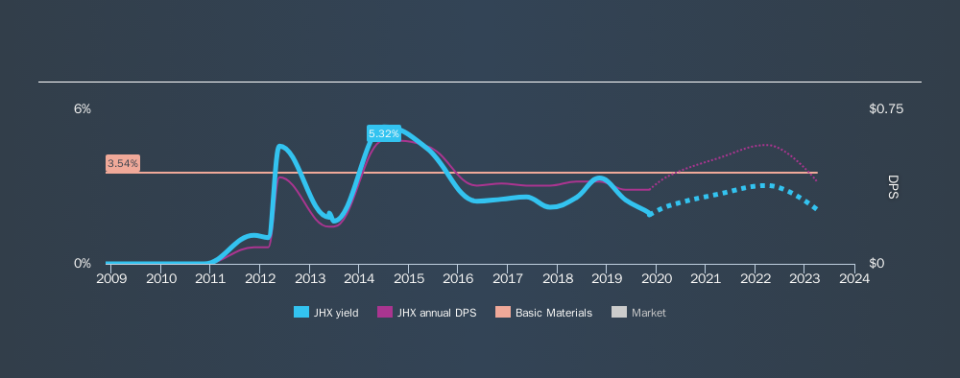4 Days To Buy James Hardie Industries plc (ASX:JHX) Before The Ex-Dividend Date

James Hardie Industries plc (ASX:JHX) stock is about to trade ex-dividend in 4 days time. You will need to purchase shares before the 15th of November to receive the dividend, which will be paid on the 20th of December.
James Hardie Industries's next dividend payment will be AU$0.1 per share, on the back of last year when the company paid a total of AU$0.4 to shareholders. Last year's total dividend payments show that James Hardie Industries has a trailing yield of 1.9% on the current share price of A$27.66. Dividends are an important source of income to many shareholders, but the health of the business is crucial to maintaining those dividends. So we need to check whether the dividend payments are covered, and if earnings are growing.
See our latest analysis for James Hardie Industries
Dividends are usually paid out of company profits, so if a company pays out more than it earned then its dividend is usually at greater risk of being cut. James Hardie Industries paid out 62% of its earnings to investors last year, a normal payout level for most businesses. Yet cash flow is typically more important than profit for assessing dividend sustainability, so we should always check if the company generated enough cash to afford its dividend. Over the last year, it paid out dividends equivalent to 248% of what it generated in free cash flow, a disturbingly high percentage. Our definition of free cash flow excludes cash generated from asset sales, so since James Hardie Industries is paying out such a high percentage of its cash flow, it might be worth seeing if it sold assets or had similar events that might have led to such a high dividend payment.
While James Hardie Industries's dividends were covered by the company's reported profits, cash is somewhat more important, so it's not great to see that the company didn't generate enough cash to pay its dividend. Cash is king, as they say, and were James Hardie Industries to repeatedly pay dividends that aren't well covered by cashflow, we would consider this a warning sign.
Click here to see the company's payout ratio, plus analyst estimates of its future dividends.
Have Earnings And Dividends Been Growing?
Companies with consistently growing earnings per share generally make the best dividend stocks, as they usually find it easier to grow dividends per share. Investors love dividends, so if earnings fall and the dividend is reduced, expect a stock to be sold off heavily at the same time. It's encouraging to see James Hardie Industries has grown its earnings rapidly, up 21% a year for the past five years. Earnings have been growing quickly, but we're concerned dividend payments consumed most of the company's cash flow over the past year.
Another key way to measure a company's dividend prospects is by measuring its historical rate of dividend growth. James Hardie Industries has delivered an average of 21% per year annual increase in its dividend, based on the past eight years of dividend payments. It's exciting to see that both earnings and dividends per share have grown rapidly over the past few years.
Final Takeaway
From a dividend perspective, should investors buy or avoid James Hardie Industries? Earnings per share growth is a positive, and the company's payout ratio looks normal. However, we note James Hardie Industries paid out a much higher percentage of its free cash flow, which makes us uncomfortable. Overall we're not hugely bearish on the stock, but there are likely better dividend investments out there.
Wondering what the future holds for James Hardie Industries? See what the nine analysts we track are forecasting, with this visualisation of its historical and future estimated earnings and cash flow
If you're in the market for dividend stocks, we recommend checking our list of top dividend stocks with a greater than 2% yield and an upcoming dividend.
We aim to bring you long-term focused research analysis driven by fundamental data. Note that our analysis may not factor in the latest price-sensitive company announcements or qualitative material.
If you spot an error that warrants correction, please contact the editor at editorial-team@simplywallst.com. This article by Simply Wall St is general in nature. It does not constitute a recommendation to buy or sell any stock, and does not take account of your objectives, or your financial situation. Simply Wall St has no position in the stocks mentioned. Thank you for reading.

 Yahoo Finance
Yahoo Finance 
